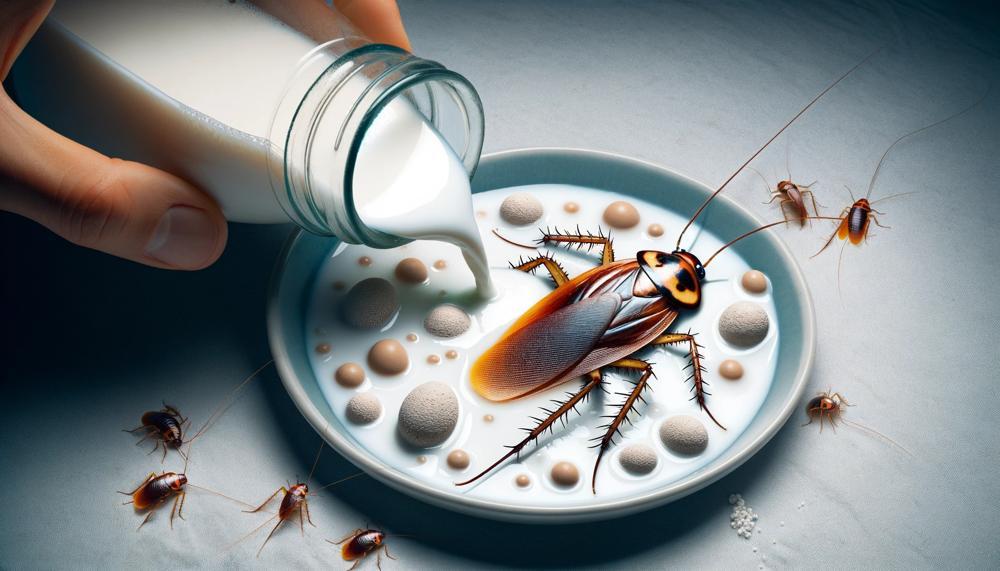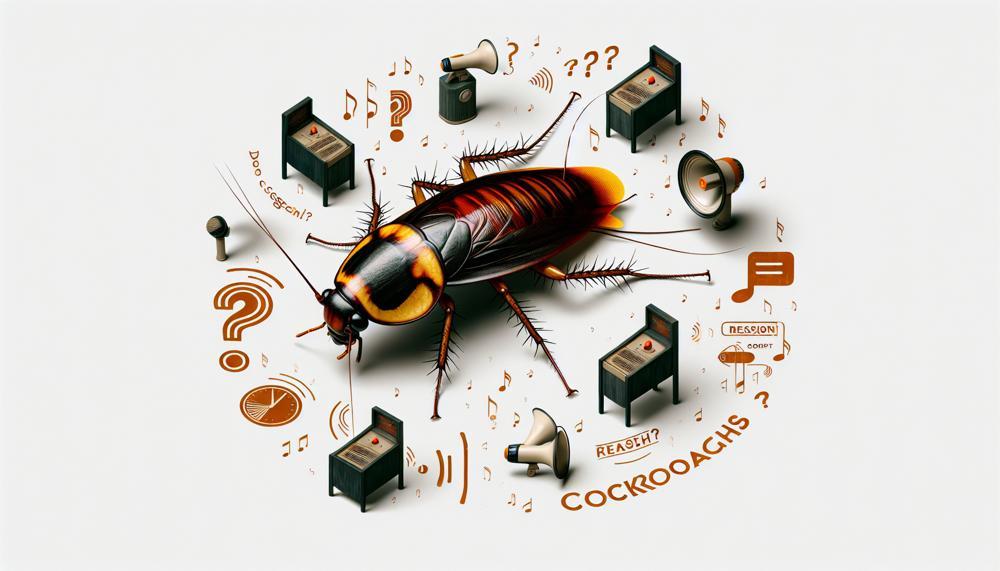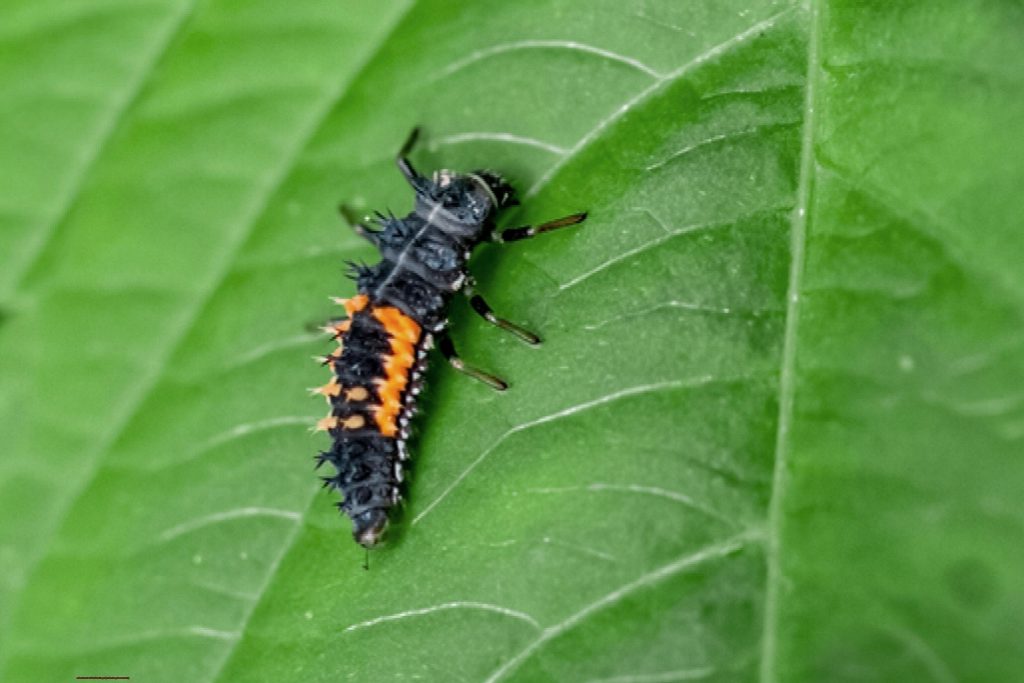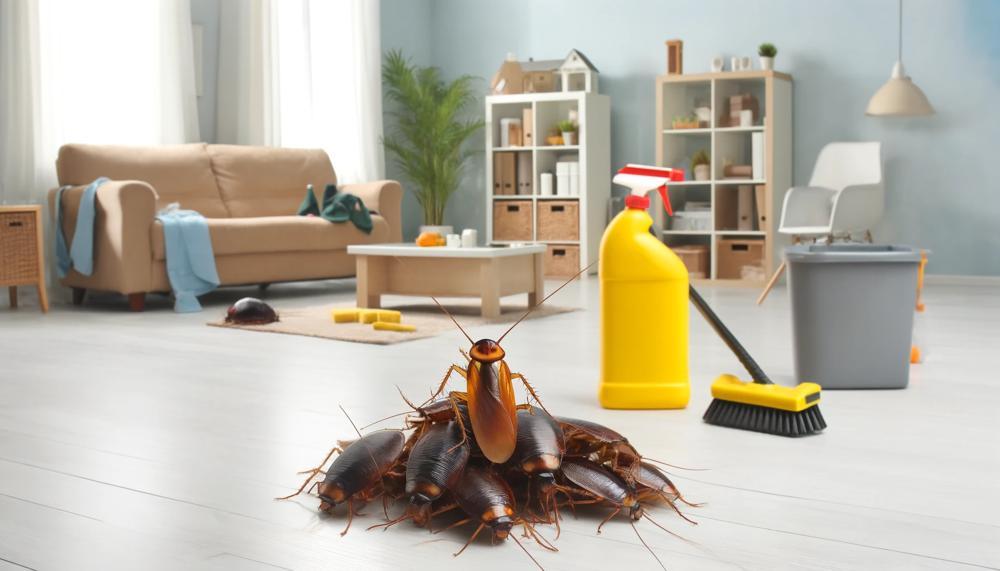Did you know that a single cockroach can lay anywhere from 10 to 50 eggs at a time? This startling fact underscores a hidden menace lurking in our homes – cockroach eggs, which can be just as troublesome as the adult pests themselves. While cockroaches are a common household nuisance globally, their reproductive speed and the resilience of their eggs can turn a minor problem into an infestation before you know it.
Tackling this issue head-on, our discussion today revolves around natural strategies to eliminate these unwelcome guests without resorting to harsh chemicals.
So, how to get rid of cockroach eggs naturally?
Feel free to use these natural methods to get rid of cockroach eggs:
- Boric acid: Pour boric acid over egg sacs that are in a jar that can handle acid. Boric acid eliminates cockroach adults but not their eggs.
- Diatomaceous earth: Algae that have died and turned into this white powder. It hurts cockroaches and makes them lose water, which kills them. It also dries out eggs, which kills them.
- Coffee grounds: Cockroaches come out of hiding when they smell coffee grounds. Put water and coffee grounds in a jar and put it where you see bugs.
- Boiling water: Bugs will leave drains if you pour hot water down them. Bugs, whether they are eggs or adults, can die in the water.
So, let’s get started.
Table of Contents
- 1 What Do Cockroach Eggs Look Like?
- 2 Where Do Cockroaches Lay Eggs?
- 3 What Is A Cockroach Egg Ootheca?
- 4 How Many Eggs Does A Cockroach Lay?
- 5 How Many Cockroaches In One Egg?
- 6 What If I Find An Empty Cockroach Egg Case?
- 7 How to Get Rid of Cockroach Eggs
- 8 How to Prevent Cockroaches
- 9 Common Cockroach Species in America
- 10 The Best Pest Control Methods
- 11 Conclusion
What Do Cockroach Eggs Look Like?
Cockroach eggs, often a telltale sign of an unwelcome infestation in your dwelling, are encapsulated in a structure known as an ootheca.
The appearance of these egg cases can provide crucial clues for identification and subsequent eradication efforts within your home.
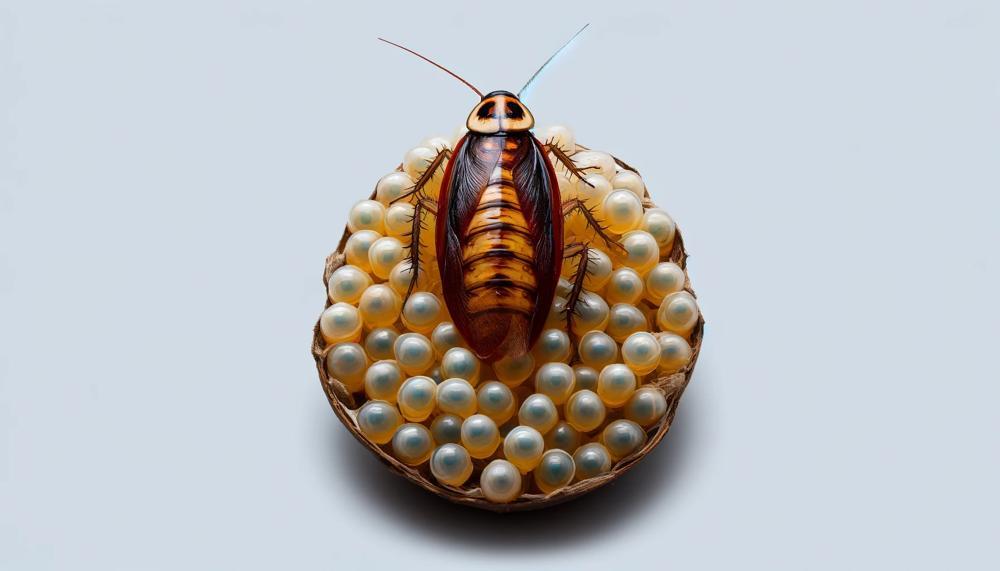
| Characteristic | Description | Common Indicators |
|---|---|---|
| Size | Generally, 5-10 mm in length. | Pill-shaped structures, easily overshadowed by the nooks and crannies of your home. |
| Colour | Ranges from dark brown to tan. | The hue might blend with the surroundings, making them harder to spot. |
| Texture and Structure | Hard exterior with a noticeable ridge. | A protective shell that’s difficult to crush, safeguarding the embryos within from most insecticides. |
| Location | Hidden; often found under appliances, within cracks, or in secluded areas near food sources. | Roaches utilise saliva to adhere these sacs in concealed spots, complicating their discovery and removal. |
| Volume | One ootheca can contain up to 48 eggs, depending on the species. | A single case can lead to a significant increase in population if left unchecked. |
Identifying cockroach eggs in your home involves a keen eye and a bit of detective work. Look for pill-shaped cases in dark, quiet spaces where roaches are likely to traverse or reside. Given their penchant for proximity to food sources, checking under kitchen appliances or within pantry crevices can be particularly fruitful.
Furthermore, the employment of Insect Growth Regulators (IGRs) is critical. These substances interrupt the reproductive cycle of cockroaches, preventing new eggs from being laid and hatched, thus providing an effective countermeasure against further infestation.
Where Do Cockroaches Lay Eggs?
Cockroaches are canny creatures, particularly when it comes to ensuring the survival of their offspring. They don’t haphazardly choose a spot to lay their eggs; rather, they’re guided by instincts honed over millennia to select environments that offer the best chance for their nymphs (baby roaches) to thrive.
- Proximity to Food and Water: Roaches are not ones to stray far from the essentials. A spot that offers easy access to food scraps, water leaks, or condensation is akin to prime real estate in the cockroach world.
- Shelter and Warmth: These critters are all about staying cozy and concealed. Warm spots near appliances or in tight, undisturbed areas provide the perfect nursery.
- Humidity Levels: They have a penchant for the damp and dreary. Areas with high humidity levels, like bathrooms or basements, attract them like magnets.
Let’s break it down further with a table illustrating common nesting sites within a home:
| Location | Reason for Preference | Common Signs of Infestation |
| Kitchens | Nearby food sources and warmth from appliances. | Live roaches scurrying at night, droppings, and egg cases. |
| Bathrooms | Moisture-rich environment. | Evidence of molting (shed exoskeletons), musty odors. |
| Basements/Attics | Less human activity, clutter provides hiding spots. | Dead roaches, droppings, and a general sense of unease. |
What Is A Cockroach Egg Ootheca?
A cockroach egg ootheca is essentially a protective casing that encases the eggs of a cockroach. This egg case is a vital part of the cockroach’s reproductive cycle, safeguarding the future generations until they are ready to hatch. Each ootheca can contain a multitude of eggs, varying from species to species, with some capable of holding up to 50 eggs.
The color and size of an ootheca can fluctuate based on the cockroach species, ranging from pale brown to dark, almost black hues, and they are typically oblong or kidney-shaped.
The presence of oothecae in your home is a clear sign of a potential or ongoing cockroach infestation. Since each ootheca can hatch multiple new roaches, even a single undetected egg case can lead to a significant increase in the cockroach population within your home. Their ability to hide in small crevices and their preference for warm, moist environments make kitchens and bathrooms prime targets for infestation.
To combat the spread and prevent the hatching of these eggs, it’s crucial to understand not only where they are likely to be found but also effective methods for their eradication.
Below is a table outlining key strategies for dealing with cockroach oothecae:
| Action | Description | Benefit |
| Identify and Remove | Locate oothecae using a flashlight; remove manually or vacuum. | Directly reduces future population growth. |
| Seal Entry Points | Use caulk to fill cracks and crevices in walls and floors. | Limits access points for adult cockroaches, reducing egg laying opportunities. |
| Maintain Cleanliness | Regularly clean floors, counters, and dispose of garbage properly. | Reduces food sources, making your home less attractive to cockroaches. |
| Reduce Humidity | Fix leaks and use dehumidifiers in damp areas. | Creates an environment less hospitable for cockroach breeding. |
How Many Eggs Does A Cockroach Lay?
The average number of eggs a cockroach lays varies significantly among species, but a common insight is their prolific breeding capability. Typically, a female cockroach lays an egg case, known as an ootheca, approximately every six weeks.
Each of these oothecae contains a varying number of eggs, highly dependent on the species in question.
Considering the lifecycle and reproductive habits of cockroaches, let’s break down the specifics:
| Species | Average Number of Eggs Per Ootheca | Frequency of Laying |
| General Cockroach | Up to 40 eggs | Every 6 weeks |
| Lifetime Egg Cases | 6 to 14 cases | Varies |
| Hatching Time | Approximately 4 weeks | |
| Development to Adulthood | 3 to 4 months | |
To put it simply, a single female cockroach can lay hundreds of eggs over her lifetime by producing multiple oothecae, each containing up to 40 eggs. This prolific breeding makes cockroaches particularly challenging pests to eradicate from homes.
For those grappling with the unwelcome presence of these critters, understanding their breeding cycle is pivotal. The key period for intervention is before the new generation hatches. Identifying and disposing of oothecae promptly, coupled with preventive measures like sealing entry points and maintaining a clean, dry environment, can significantly hinder their ability to multiply.
Remember, while these numbers provide a general guideline, variances exist among different species. Some may lay fewer eggs per case or breed at different intervals.
How Many Cockroaches In One Egg?
From a single cockroach egg, up to 8 baby cockroaches can hatch.
These little critters can make their grand entrance into the world in as little as one month, setting the stage for quite the infestation if not nipped in the bud.
Understanding Cockroach Eggs: A Closer Look
Cockroaches are infamous for their resilience and rapid reproduction rate. When it comes to dealing with them, especially for those eager to keep their abodes clear of these unwelcome guests, knowledge is power. Here’s a bit of insight into how these creatures multiply:
| Aspect | Detail | Implication |
|---|---|---|
| Egg Case (Ootheca) | Contains multiple eggs | Each case is a potential mini army of roaches. |
| Hatching Time | As soon as 1 month | Rapid increase in population if not addressed. |
| Average Number of Hatchlings | Up to 8 from one egg case | Significant potential for infestation from a single case. |
Given their prolific breeding capabilities, it’s critical to act swiftly at the first sign of cockroach eggs in your home. Disposing of egg cases and maintaining a clean environment are key strategies in preventing an army of cockroaches from taking over.
Remember, while spotting one or two cockroaches might not seem like a big deal, each egg case they produce can hatch up to 8 new roaches.
And with females laying multiple cases throughout their lives, it doesn’t take long for a small problem to become a full-blown infestation.
What If I Find An Empty Cockroach Egg Case?
Stumbling upon an empty cockroach egg case in your dwelling can be quite the wake-up call. No need to panic, though. Here’s a straightforward game plan to tackle the situation head-on and keep those unwelcome guests at bay.
Immediate Actions:
- Clean Thoroughly: First things first, grab your gloves and vacuum. Give the area around where you found the egg case a proper going-over. Cockroaches are drawn to food scraps and grease, so make sure your kitchen and dining areas are spick and span.
- Inspect Your Home: Look for any other signs of roach activity or additional egg cases. These critters are crafty and can squeeze into the tiniest of spaces. Pay special attention to hidden nooks, crannies, and any damp areas.
- Dispose of the Egg Case Correctly: Seal it in a bag and chuck it in the bin outside. You don’t want any stragglers deciding to make a comeback.
Preventative Measures:
| Action | Details | Reason |
| Seal Entry Points | Use caulk to seal cracks around windows, doors, and pipes. | Prevents roaches from entering your home. |
| Keep It Dry | Fix leaks and ensure your home is well-ventilated. | Cockroaches love damp environments. |
| Store Food Properly | Use airtight containers for food storage. | Eliminates food sources for roaches. |
| Regular Cleaning | Vacuum and mop floors regularly; don’t forget about under appliances. | Reduces crumbs and grease that attract roaches. |
| Professional Pest Control | If the problem persists, consider hiring experts. | Sometimes DIY methods aren’t enough to tackle an infestation. |
How to Get Rid of Cockroach Eggs
Eliminating cockroach eggs from your home naturally involves a combination of proactive and reactive strategies.
| Natural Method | Description | Application |
|---|---|---|
| Baking Soda and Sugar Mixture | A concoction that exploits the fatal reaction cockroaches have to baking soda when ingested. | Mix equal parts baking soda and sugar. Scatter the mixture near suspected egg-laying sites and where roaches frequent. The sugar attracts them, while the baking soda kills them internally. |
| Boric Acid | A naturally occurring compound that is lethal to cockroaches upon contact or ingestion. | Lightly sprinkle boric acid in hidden areas where roaches and their eggs are likely found. Avoid heavy application to prevent roaches from avoiding the area. |
| Essential Oils Spray | Certain essential oils repel and even kill cockroaches due to their potent properties. | Create a spray by mixing water with a few drops of either citrus, eucalyptus, lavender, peppermint, or lemongrass oil. Spray in corners, cracks, and crevices. |
| Diatomaceous Earth (DE) | A natural abrasive powder that damages the exoskeleton of cockroaches, leading to dehydration and death. | Apply food-grade DE around baseboards, in drawers, and other dark, moist areas where eggs might be laid. Ensure the area is dry for DE to be effective. |
| Neem Oil | Derived from the neem tree, it acts as an insecticide against cockroaches when ingested. | Mix neem oil with water and spray in areas where cockroach activity is high. Can also be used directly on egg cases to inhibit hatching. |
Remember, these methods should be used consistently over time for best results. Also, maintaining cleanliness in your home, especially in the kitchen and bathroom, is crucial to deter cockroaches from laying eggs in the first place.
How to Prevent Cockroaches
Preventing cockroaches from laying eggs in your home naturally involves a combination of strategies aimed at making your environment inhospitable to these pests. Here are some effective natural methods:
| Method | Description | How It Works |
| Maintain cleanliness | Keep your home clean, especially the kitchen, to remove food sources. | Reduces attraction for cockroaches to settle and lay eggs. |
| Seal entry points | Fill cracks and crevices in walls, around pipes, and in foundations. | Limits access points for cockroaches into your home. |
| Boric acid | A natural substance that can be sprinkled in hidden areas. | Dehydrates and kills cockroaches upon contact but must be used cautiously. |
| Diatomaceous earth (Food Grade) | A fine powder made from fossilized algae. | Similarly dehydrates roaches when they come into contact with it. |
| Essential oils | Peppermint, cypress, and tea tree oils are disliked by roaches. | Mix with water and spray in areas where roaches frequent to deter them. |
| Bait with natural substances | Create a mixture of sugar and baking soda. | Cockroaches are attracted to the sugar but cannot digest the baking soda, leading to extermination. |
| Proper waste management | Ensure trash is disposed of promptly and containers are sealed. | Minimizes food sources and reduces roach attraction to your home. |
| Control moisture | Fix leaks and ensure areas like basements are dry. | Cockroaches thrive in moist environments; reducing moisture deters their presence. |
| Bay leaves | A natural repellent, bay leaves can be placed in cupboards and drawers. | The smell is unappealing to cockroaches and can help keep them away. |
Common Cockroach Species in America
In the battle against home invaders of the six-legged variety, knowing your enemy is half the battle. For those of you gearing up to tackle cockroach infestations, here’s a detailed lineup of the usual suspects across America.
From the sneaky German cockroach to the flight-capable Australian, these critters are not just uninvited guests but also crafty survivors.
| Species | Identification | Hangout Spots |
| German Cockroach (Blattella germanica) | Small, light brown, with two dark stripes behind the head | Kitchens and bathrooms, loves warmth and moisture |
| American Cockroach (Periplaneta americana) | Larger, reddish-brown, capable of flying short distances | Basements, sewers, prefers cooler spots than its German counterpart |
| Oriental Cockroach (Blatta orientalis) | Dark brown or black, often called “water bugs” | Thrives outdoors in leaf litter but will venture indoors for food |
| Brown-banded Cockroach (Supella longipalpa) | Smaller, with distinctive lighter bands across the wings | Prefers dry and warm areas like appliance motors or upper cabinets in homes |
| Smoky Brown Cockroach (Periplaneta fuliginosa) | Smokey brown color, requires more water than other species | Rarely indoors; loves woodpiles and palm trees outside |
| Australian Cockroach (Periplaneta australasiae) | Slightly smaller than the American roach, with yellow stripes on its wings | Outdoor dweller but can fly indoors searching for food or warmth |
| Brown Cockroach (Periplaneta brunnea) | Mistaken for the American cockroach but thrives in plant matter rich environments | Greenhouses or commercial facilities with ample plant material are prime real estate for these critters. |
The Best Pest Control Methods
Tackling the problem of cockroach eggs in your home requires a multifaceted approach, blending natural methods with a bit of know-how. Here’s a guide to help you banish these unwelcome guests without resorting to harsh chemicals.
| Method | How It Works | Application |
| Boric Acid | Acts as poison. | Apply in crevices and where eggs are spotted. |
| Insect Growth Regulators | Disrupts development of eggs. | Use as directed on product. |
| Baking Soda and Sugar Mix | Bait that reacts internally. | Spread near egg locations. |
| Diatomaceous Earth | Causes dehydration. | Dust over areas with egg presence. |
| Essential Oils | Repels through scent. | Spray diluted solution around affected areas. |
| Vinegar | Cleans trails to deter future infestations. | Wipe surfaces where cockroaches travel. |
Using these methods, you can tackle cockroach eggs effectively while keeping your home safe from harsh chemicals.
Conclusion
We need to be careful and creative at the same time to fight cockroaches in our homes. Cockroach eggs, which are tiny, hard-shelled packages of future pests, are a threat that needs a solution that works and doesn’t hurt the environment. Without us realizing it, our homes can become battlegrounds where cockroaches reproduce in secret, with each egg case possibly bringing in a new wave of unwanted guests.
We can break this loop if we know how and use natural alternatives. The first thing we need to do to protect ourselves is identify the ootheca. Finding its hiding places is very important. Being careful in places like behind our fridges, under our sinks, and where it’s warm and damp can stop these pests from having a lot of babies. When you use natural methods like diatomaceous earth, boric acid, and homemade mixtures of baking soda and sugar, you not only kill adult bugs but also kill their offspring.
But prevention is the most important part of long-term pest control. By blocking off entry spots, keeping things clean, and controlling wetness, you can make your home uninviting to cockroaches. By making these habits a part of our daily lives, we protect our houses from attacks and make sure they stay safe places to be, not battlegrounds.
In our fight to get these tough pests out of our homes, let’s rely on nature’s knowledge and the power of prevention. Killing cockroach eggs isn’t the only goal; you also want to make your home a place of peace, health, and strength.

